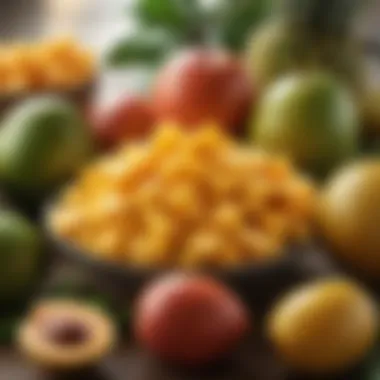Crafting the Perfect Mango Smoothie: A Complete Guide


Intro
Mango smoothies have made their mark not just as a tasty treat but also as a nutritional powerhouse that can be enjoyed any time of the day. The juicy, tropical flavor of mango combined with creamy textures offers not only a delightful experience but also a wholesome addition to your diet. Whether you're looking to refuel after a workout, seeking a quick breakfast solution, or just craving a refreshing drink on a hot day, mastering the art of crafting a mango smoothie is essential.
This guide dives into what it takes to make the perfect mango smoothie. From selecting the finest ingredients to understanding the intricacies of preparation techniques, every detail matters. The key is not just tossing together some fruits; it's about balance, nutrition, and most importantly, flavor.
What makes this guide especially notable is its approach to cater to various dietary preferences. There’s something here for vegans, lactose-intolerant folks, or anyone who simply wants to enhance their culinary skill set. Thus, whether you are a beginner or an experienced cook, you'll discover valuable insights designed to elevate your smoothie game.
"A mango smoothie is not just about the taste; it’s about refreshing your body and mind, making every sip a cheerful moment."
Let’s embark on this flavorful journey, ensuring that by its end, you’ll feel not only capable but also excited to blend your own delicious mango smoothies.
Prelims to Mango Smoothies
Mango smoothies have carved out a special niche in the realm of blended beverages. They aren't just about appealing aesthetics; there’s a depth of flavor and nutritional value packed into each delightful sip. Mangoes, with their luscious texture and tropical taste, bring that vacation vibe right into your kitchen. Whether you're whipping up a post-workout recovery drink or a refreshing afternoon snack, a mango smoothie fits the bill perfectly.
What sets this tropical delight apart? Mango smoothies are versatile. You can play around with various ingredients, tailoring each recipe to match your taste preferences and dietary needs. From adding greens for an extra nutrient boost to experimenting with spices like cinnamon or ginger for a kick, the possibilities are as wide as the ocean. This flexibility makes mango smoothies perfect for everyone—from health enthusiasts to those simply craving something sweet and satisfying.
Also, making mango smoothies is a relatively simple affair. With just a few ingredients, you can create a deliciously smooth blend in minutes. It’s all about understanding the key components, from selecting the right mango varieties to mastering the blending techniques.
Furthermore, the health benefits are substantial. Mangoes are rich in vitamins A and C, fiber, and antioxidants, making them a wise choice for anyone seeking to improve their overall nutrition. When combined with other ingredients like yogurt or protein powder, it transforms into a balanced meal option that can easily fit into different dietary patterns.
To sum it up, the appeal of mango smoothies lies not only in their enticing flavor but also in their adaptability and nutritional perks. This introduction sets the stage for a journey through the intricate world of crafting the perfect mango smoothie, an exploration that promises to enrich your culinary repertoire. Get ready to dive deeper.
Understanding Mango Varieties
When it comes to crafting the perfect mango smoothie, recognizing the different types of mangoes plays a pivotal role. Just like wine aficionados can distinguish between a Merlot and a Cabernet, smoothie enthusiasts should know their mango varieties. Each type brings its unique flavor, sweetness, and texture, which can dramatically influence your smoothie’s overall profile. Knowing these variations allows for informed choices, ensuring that each sip is bursting with the best possible taste.
Mango varieties can range from the common Haden and Tommy Atkins to the more exotic Alphonso. Each brings a different shade of sweetness and dimension to a smoothie, making it essential to pick the right one for your intended flavor.
Common Types of Mangoes
- Haden: Recognized for its rich sweetness and a hint of tartness, Haden mangoes are often considered a classic choice. Their vibrant red and green skin make them quite appealing. In smoothies, they deliver a bold flavor that’s sure to please anyone's palate.
- Tommy Atkins: This variety is surely the most widely available. While not the sweetest, Tommy Atkins bring a slightly fibrous texture and mild flavor. It’s a reliable choice for smoothies when you want other ingredients, such as fruits or yogurt, to shine through.
- Alphonso: Often deemed the ‘king of mangoes,’ its creamy texture and rich sweetness provide a delightful experience. This variety tends to be a little harder to find but worth the hunt. Its intense taste elevates any smoothie to a whole new level.
- Kent: Known for its juicy and fiber-free flesh, Kent mangoes offer an ideal blend of sweetness without becoming overwhelming. Their green and dark red skin indicates their tropical origins, and they blend beautifully, creating a smooth texture that’s perfect for smoothies.
Selecting Ripe Mangoes
Choosing ripe mangoes is an art and a science. The process requires a keen eye and an understanding of various indicators that signal readiness.
Visual Indicators
A ripe mango often exhibits a vibrant shade of yellow or orange. Look for a mango that has a few dark spots, as these indicate sweetness. Avoid mangoes with overripe patches or large dents; they might taste fine but could have an off texture in your smoothie. The color and visual signals are largely what draw people in, and getting a good one will significantly impact your drink’s flavor payoff.
Touch and Aroma
Gently squeezing a mango is essential to gauge its ripeness. It should yield slightly, indicating it's got the juiciness locked inside. A mango’s aroma should be fragrant, with a sweet scent that wafts through the air. This olfactory cue often suggests that the mango is ripe or nearing perfect readiness for blending. If it smells off or has no scent, it might be underripe or past its prime. The feel and scents coming from the fruit can often tell you more than just a glance at the skin.
Essential Ingredients for Smoothie Making
When it comes to crafting a mango smoothie, the ingredients you choose can make or break your endeavor. Having the right components not only enhances the flavor but also ensures the smoothie meets your nutritional goals. It’s beneficial to understand the essential ingredients involved in this process, including the base ingredients and the flavor enhancers.
Base Ingredients
Fresh vs. Frozen Mango
Let's dive into the discussion of fresh and frozen mangoes. Fresh mangoes, while vibrant and flavorful, can be tricky to get ripe. They require a keen eye to determine the perfect level of ripeness. On the other hand, frozen mangoes provide convenience. They’re picked at peak ripeness and then frozen, preserving the lush taste and texture. This characteristic makes frozen mangoes a popular choice for quick smoothies. You can just toss them in, no fussing over cuts or ripeness needed.
However, fresh mango fans argue for the rich flavor only fresh fruit can offer, as it can sometimes outshine its frozen counterpart in terms of taste and aroma. But really, it often boils down to personal preference and what you have on hand. So both options serve well, depending on your needs and resources.
Dairy and Non-Dairy Options
Now, another pivotal part of your smoothie involves dairy and non-dairy choices. Dairy-based ingredients, such as yogurt or milk, add creaminess and a dose of protein. These options can significantly enhance your smoothie, giving it that indulgent mouthfeel. Plus, they can make your smoothie more satiating.
In contrast, non-dairy alternatives like almond milk or coconut yogurt are fantastic for those with lactose intolerance or those preferring plant-based diets. They can lend unique flavors that complement the mango, sometimes offering a nutty or tropical twist. The risk here could be a thinner consistency if you’re not careful, but using a mixer effectively can level things out.
Flavor Enhancers
Sweeteners
Sweeteners can be the game-changer when it comes to the final flavor of your smoothie. Although mangoes are naturally sweet, adding a touch more sweetness can elevate the whole experience. Options like honey, agave nectar, or maple syrup can do wonders. They not only bring sweetness but can also add another layer of flavor. Understanding how much to add can be tricky. Too much, and you might tip the scales into saccharine territory. A little pinch goes a long way, so start small.
Spices and Additives
Now let’s explore spices and additives. Don't overlook the potential of these ingredients. A dash of cinnamon can bring warmth, while turmeric boasts its health benefits. You might consider vanilla extract for an aromatic lift. Each of these elements can contribute to a more complex flavor profile. Plus, they can enhance the nutritional value of your smoothie, which is a win-win.
"Each ingredient not only shapes the taste but also contributes to the overall health benefits of your smoothy. Being thoughtful about your choices can lead to a more satisfying drink."
Preparation Techniques
Preparation techniques play a crucial role in crafting the perfect mango smoothie. These methods not only ensure that the ingredients come together harmoniously, but they also significantly influence the overall taste and texture. With the right preparation, you can elevate an ordinary smoothie to extraordinary heights, blending flavors and nutrients seamlessly.
Peeling and Cutting Mangoes
When it comes to peeling and cutting mangoes, there's more subtely to it than meets the eye. The first thing to grip is that mangoes can be tricky due to their slippery surface and large pit. Start by washing the mango under running water. This step helps remove any residue, ensuring your smoothie remains pure and tasty.
Next, the method of cutting matters immensely. You can use a peeler for the exterior, but many opt for slicing off the cheeks. To do this, cut alongside the pit on either side. The mango’s flesh is juicy and sweet, making it worth a little effort. Once you have the cheeks, you can cube the flesh easily by scoring it in a grid pattern with your knife, then scooping those succulent pieces out with a spoon. This technique not only preserves more of the fruit but also allows for a smoother blending experience.


Blending Techniques
Optimal Blender Settings
Selecting the right blender settings is essential for achieving a smooth and creamy mango smoothie. A high-speed blender often works best for this task, as it allows all ingredients to be thoroughly combined. Use the “smoothie” or “blend” presets if available on your device, as these are specifically designed to create velvety textures. Start at a low speed to break down the larger mango pieces before ramping up to high speed for a few seconds. This method can help in creating that luscious homemade feel.
The unique feature of optimal settings is the ability to control texture. For example, starting on low and finishing on high can make an enormous difference in how smoothly everything comes together, helping to eliminate those pesky chunks that can sometimes plague lesser blends.
Avoiding Common Mistakes
When crafting any mango smoothie, avoiding common mistakes is just as important as knowing the right techniques. A frequent pitfall is adding too much liquid initially, leading to a soupy disaster rather than a smooth and creamy experience. Instead, start with the base ingredients like mango, which already has some moisture, then add liquids gradually, ensuring you don’t end up with a smoothie that’s more like a mango-flavored drink.
Another common mishap is not letting your blender do the work. Sometimes, impatient blenders stop prematurely. Allow your blender to run a bit longer, especially after combining the ingredients, giving them the chance to mingle and merge into that beautiful mix. The pure advantage of making sure everything is well-blended cannot be overstated.
The right preparation techniques can significantly enhance the flavor and consistency of your smoothie, setting the stage for a deliciously rich concoction.
In summary, mastering the peeling and cutting of mangoes, knowing your blender settings, and avoiding common mistakes in the blending process are vital steps to developing a perfect mango smoothie. Implementation of these techniques will elevate the dish to an experience that engages all senses, transforming your smoothie into something uniquely tantalizing.
Creating a Balanced Smoothie
Creating a well-balanced smoothie is the cornerstone of crafting a delicious mango smoothie. It's all about harmonizing different elements to achieve that perfect sip. Balance can be defined by how the flavors interact, the texture feels on the palate, and nutritional requirements too. Understanding the components that contribute to a balanced smoothie not only enhances the flavor but also boosts the overall health benefits.
One must consider several key factors when striving for the ideal balance:
- The ratio of fruit to liquid
- Sweetness and acidity levels
- The inclusion of additional ingredients like greens and protein sources
By thoughtfully blending these elements, you can produce a mango smoothie that is not too thick or thin and bursts with flavor without being overwhelming.
Achieving Ideal Texture
Adjusting Liquid Consistency
Liquid consistency fundamentally shapes the texture of your smoothie. It's essential to tailor the amount of liquid based on the other ingredients you're using. Too much liquid can result in a smoothie that resembles juice, while too little can make it a sticky paste. A good guideline is to start with a base, like coconut water or almond milk, and then gradually add more until you reach a velvety smooth consistency. This measure ensures that your mango flavor remains prominent.
One key characteristic of adjusting liquid consistency is its flexiblity. By altering it, you can quickly cater to personal preferences; whether your taste leans toward creamy or more refreshing nuances, controlling liquid amounts offers versatility. This adjustment feature stands paramount in this article; achieving texture consistency is beneficial as it can turn a lump of fruit into a delightfully cohesive drink.
Advantages of managing this aspect include:
- Avoiding overly watery or thick textures
- Enhancing the overall mouthfeel and satisfaction
But keep in mind, too much alteration can dilute the vibrant flavors derived from ripe mangoes. Balance is key.
Using Ice and Frozen Ingredients
Incorporating ice or frozen versions of mango is an excellent strategy to amplify your smoothie’s texture while also keeping it refreshingly cold. It helps in creating a luxurious mouthfeel, lending that iconic smoothie quality. Ice or frozen fruits can make the drink thicker, which eliminates the need for excessive liquid, maintaining a concentrated flavor. This technique is particularly popular because it creates a frosty treat that is perfect for hot days.
What sets this method apart is its convenience; you can warehouse chopped mangoes or other fruits in your freezer, allowing for quick smoothie preparation anytime. However, relying too heavily on ice can lead to a watered-down taste. Monitoring how much you use is crucial.
Benefits of incorporating ice and frozen elements include:
- Providing a refreshing chill
- Enhancing texture without bloating the flavor profile
Balancing Flavor Profiles
Sweetness Versus Acidity
Understanding the interplay between sweetness and acidity is a vital step toward creating a complex flavor experience in your smoothie. Ripe mangoes add a natural sweetness, but if that’s your only flavor guidepost, it can come off too cloying. Introducing something acidic, such as a splash of yogurt or a hint of lime juice, can level out that sweetness beautifully.
A crucial aspect of this balance is its role in the overall tone of the smoothie. When sweetness pairs with acidity, it adds depth, making every sip intriguing rather than monotonous. Such contrasts are what make desserts delightful, and they apply just the same for smoothies. It’s a beneficial choice as it gives the drink a more rounded profile while ensuring no one flavor overwhelms.
The advantages of managing sweetness and acidity include:
- Enhanced flavor complexity
- A more enjoyable drink that appeals to various palates
Incorporating Citrus
Citrus fruits, such as oranges or lemons, can add a zest that not only balances the sweetness of your mango but can also brighten the entire smoothie. The tangy flavor of citrus cuts through and adds a refreshing sharpness that can lift the drink. It’s a beneficial choice because it adds vibrancy.
The unique feature of incorporating citrus is that it also amps up the nutritional value. Citrus fruits are rich in vitamin C, which can provide an immune boost. Unlike other additions that can weigh down a smoothie, citrus keeps it light and invigorating.
Some benefits include:
- Boosting the nutrient profile
- Maintaining a refreshing taste
Consider this: Balance is the secret ingredient in any successful mango smoothie recipe. Mastering how to tweak your texture and flavor will lead you to the ultimate drink.
Nutritional Aspects of Mango Smoothies
Understanding the nutritional aspects of mango smoothies is crucial for anyone keen on making not just delicious, but also health-conscious choices. Mangoes are more than just a sweet treat; they offer a wealth of nutrients that can significantly contribute to a well-rounded diet. This section dives into the health benefits of mangoes, including essential vitamins and minerals, as well as their fiber content. Additionally, we will see how the mango smoothie can be tailored to various dietary preferences.
Health Benefits of Mangoes
Mangoes hold a prominent place in the health food narrative, rich in both flavor and nutrients. Let's discuss two key elements: vitamins and minerals, along with fiber content.
Vitamins and Minerals
Mangoes are loaded with vitamins, particularly vitamin C and vitamin A. Vitamin C is known for its role in boosting immunity; it helps in the production of collagen, which is essential for healthy skin. Also, vitamin A plays an important role in vision and immune function. These characteristics of vitamins make mangoes a valuable choice in a smoothie, providing both taste and health benefits.


- Key Vitamins:
- Vitamin C: Aids in absorption of iron and improves skin.
- Vitamin A: Essential for eye health.
Another aspect is the mineral content. Mango smoothies can sneak in potassium and magnesium, contributing to cardiovascular health and muscle function. A unique feature of these minerals is their ability to help regulate blood pressure, adding a layer of benefit that might just make that smoothie a staple in your diet.
Fiber Content
The fiber content in mangoes is noteworthy too. Fiber supports digestive health by promoting regularity and preventing constipation. Having a high-fiber diet is linked to a lower risk of chronic diseases, making it an important factor for those focusing on long-term health. When blended into a smoothie, this fiber helps create a more satisfying drink that keeps hunger at bay.
- Fiber Benefits:
- Satiating Effect: Keeps you feeling full longer.
- Digestive Health: Promotes regular bowel movements.
The unique quality of fiber is its ability to slow the absorption of sugar, which can help manage blood sugar levels. For those concerned with diabetes or metabolic health, incorporating mango smoothies can be a smart, tasty choice.
Tailoring Smoothies for Diets
Mango smoothies are versatile enough to fit into various dietary plans. Let’s explore how one can tailor them, focusing on low-calorie versions and high-protein alternatives, each catering to different goals and preferences.
Low-Calorie Versions
For those eyeing weight management, low-calorie versions of mango smoothies can be quite beneficial. By substituting calorie-dense ingredients with lighter options, like using almond milk instead of regular yogurt or blending mango with leafy greens, one can enjoy a refreshing drink that keeps the caloric intake in check.
- Key Characteristics:
- Lighter Alternatives: Use non-fat yogurt or water.
- Fruit Blends: Mix with lower-calorie fruits like berries.
This approach not only maintains flavor but also ensures you’re getting a nutritious boost without overindulging. The unique feature of low-calorie smoothies is their ability to give you energy without the heaviness that often comes with richer drinks.
High-Protein Alternatives
Additionally, high-protein alternatives are vital for those looking to increase their protein intake. Adding ingredients like Greek yogurt, protein powder, or even silken tofu can elevate the protein content significantly. This is particularly helpful for athletes or anyone looking to build muscle.
- High-Protein Characteristics:
- Rich in Nutrients: Enhances muscle repair and growth.
- Sustained Energy: Keeps you fuller for longer, preventing snacking.
One unique aspect of high-protein smoothies is that they can serve as meal replacements, ensuring you’re still getting essential nutrients without resorting to heavier meals. This makes them an appealing option for busy individuals.
"The right balance of nutrients in your mango smoothie can transform it from a delicious drink into a vital part of a healthy lifestyle."
By understanding these nutritional aspects and making mindful choices, anyone can transform their mango smoothie into a powerhouse of health benefits, tailored perfectly to their dietary needs.
Exploring Variations and Add-Ins
When it comes to mango smoothies, the beauty lies not only in the mango itself but also in the canvas it provides for culinary creativity. Exploring variations and adding thoughtful ingredients can dramatically elevate the overall experience. By combining different flavors and textures, one can create smoothies that are not only pleasing to the palate but also tailor them to specific nutritional needs or taste preferences. In this section, we will examine how introducing other fruits and greens can broaden your smoothie horizons, as well as how superfood additions can enhance health benefits.
Tropical Smoothie Variations
Combining with Other Fruits
Mango is a fantastic base for smoothies, but it plays well with others. Combining mango with fruits like pineapple, banana, and berries can create a symphony of flavors. For instance, the tartness of pineapple can counterbalance the sweetness of mango, achieving a more complex taste profile. Additionally, bananas offer a creamy texture, enhancing the smoothie’s mouthfeel.
The main draw of mixing fruits is versatility. You can tailor the combination depending on the season or your mood. For example, during hotter months, a tropical blend with kiwi and coconut water can evoke a beachy vibe. However, it's crucial to keep in mind the sugar content in certain fruits. Too much sweetness can make the smoothie overwhelming. Striking a balance between flavors is key to a satisfying result.
Adding Greens
Incorporating greens into your mango smoothie isn’t just about boosting nutritional content; it's also about color and texture. Spinach and kale are popular choices, adding vibrant color and fiber without overwhelming the mango's flavor. One of the remarkable aspects of greens is that they blend seamlessly, allowing you to enjoy a nutrient-rich beverage without compromising on taste.
Moreover, greens like kale are packed with vitamins A, C, and K, which are invaluable for overall health. The downside? Some people may find the earthy flavor of certain greens unappealing, so it’s best to start with small amounts and adjust as desired to ensure the flavors merge harmoniously.
Superfood Add-Ins
Chia Seeds
Chia seeds are a powerhouse addition to your mango smoothie. They are rich in omega-3 fatty acids, fiber, and protein. The beauty of adding chia is their ability to absorb liquid, which turns them into little gel-like pearls. This characteristic not only heightens the texture of your smoothie but also helps you feel fuller longer.
One thing to be aware of when using chia seeds is the increase in thickness. If you prefer a drinkable smoothie, it’s wise to regulate the amount you add or adjust the liquid content to maintain the desired consistency. Overall, chia seeds can serve as a great supplement to enhance both health and satisfaction.
Protein Powders
For those seeking an additional protein boost, protein powders are an excellent choice. Whether you opt for whey, plant-based, or specialty blends, they can seamlessly fit into your mango smoothie. This addition is particularly beneficial if you’re using the smoothie as a meal replacement or post-workout recovery drink.
The key feature of protein powder is its convenience. A scoop or two can easily ramp up the protein content without altering the foundational taste of the mango. However, some protein powders can have added sugars or artificial flavors, so it’s worthwhile to check ingredients to find a high-quality option that aligns with your dietary goals.
In summary, exploring variations and add-ins is about personal expression and nutritional optimization. The combinations of fruits and greens create diverse flavors, while superfood additions enhance the health benefits. So next time you throw a mango smoothie together, consider how these elements can help you craft a drink that’s not just delicious but fulfilling as well.
Storing and Serving Mango Smoothies
The enjoyment of mango smoothies doesn't have to end immediately after they are made. Knowing how to properly store and serve them can enhance the experience significantly. Storing smoothies correctly helps maintain freshness and flavor while serving them efficiently adds to the aesthetic appeal. Delving into these aspects, there are essential factors to consider that will make every sip enjoyable.
Storage Recommendations
Refrigeration Tips


Storing your mango smoothie in the fridge is a straightforward and effective method. When done right, refrigeration allows the flavors to meld, making the smoothie even more delightful after a few hours. Here’s what to keep in mind:
- Use airtight containers: This prevents air from spoiling your smoothie and avoids absorbing other odors in the refrigerator.
- Consume within 24 hours: For optimal taste and nutrients, it's best to drink your smoothie fresh. However, if stored correctly, it can last up to two days; just give it a good shake before drinking.
- Consider freezing fruits separately: This lets you blend the smoothie fresh whenever you crave it.
The key characteristic of refrigeration is its convenience, allowing for quick access when hunger strikes. Although it’s a good choice, avoid letting smoothies sit for too long, as the texture can change over time, turning it from silky smooth to somewhat unappealing. The unique aspect of refrigeration is its ability to suspend the freshness for a limited time but be mindful of the potential for flavor degradation.
Freezing for Later
Freezing your mango smoothie or its ingredients is another option worth exploring. It's a great technique if you want to prepare smoothies in advance for the week ahead without worrying about spoilage. Here’s how to navigate this method:
- Use freezer-safe containers: This stops freezer burn, keeping your smoothie tasty.
- Portion control: Consider freezing smoothies in individual servings; that way, you can grab one quickly whenever needed.
- Leave space in containers: Liquids expand when frozen, so avoid filling containers to the brim.
The standout feature of freezing is its ability to prolong the lifespan of your smoothie, making it particularly beneficial for meal prepping. Yet, smoothies stored this way may need extra blending time to achieve that creamy consistency once thawed. While a frozen smoothie can sometimes lose a bit of flavor, it still retains most of its nutritional value, making it a viable option.
Ideal Serving Suggestions
Now that your smoothie is stored beautifully, think about how to serve it. Serving isn't just about handing over the drink; it’s about presentation and ensuring the drink is enjoyed to the fullest.
Glassware Choices
When it comes to presenting your mango smoothie, the type of glass you use can make a difference.
- Tall glasses: These are ideal for layer presentations, giving your smoothie a visually appealing aspect.
- Mason jars: For a rustic touch, mason jars add a charming vibe, especially for outdoor settings.
- Frosted glasses: A frosty exterior provides a refreshing touch, especially in hot weather.
Choosing appropriate glassware not only enhances the visual appeal but also affects drinking experience. A well-chosen glass can keep smoothies chilled longer and offers a tactile enjoyment that plastic cups simply cannot match.
Garnishing Techniques
Garnishing is an art, and it can elevate a simple mango smoothie into a true work of culinary appeal. With the right toppings, you can invite people to appreciate flavors before they sip.
- Fruit slices: Adding slices of mango or citrus on the rim gives a pop of color and hints at the delightful flavors within.
- Herbs: Fresh mint or basil can add a surprising aromatic layer that enhances flavor.
- Seeds or nuts: Sprinkling chia seeds or crushed nuts gives a crunchy texture, appealing to various taste preferences.
The beauty of garnishing lies in its ability to transform an everyday drink into a stunning showcase. Each technique you choose has its own advantages, with flavor and visual appeal calling the shots to impress guests or simply treat yourself.
Remember, storing and serving your mango smoothies impeccably can enhance both their shelf life and enjoyment, making every smoothie moment a memorable one.
Common Challenges and Solutions
When diving into the art of crafting a mango smoothie, one might run into a few bumps along the road. Recognizing and addressing common challenges not only smoothens the smoothie-making process but also makes for a more enjoyable experience. This guide highlights some frequent issues that afflict amateur and seasoned smoothie enthusiasts alike—like achieving the right consistency or combating flavor mishaps. Tackling these challenges is crucial because it ensures that every smoothie created is a blend of delight and nourishment, rather than a mere fruit muddle.
Overly Thick or Thin Smoothies
Adjusting Consistency
The consistency of a smoothie can make or break the drink. When it's too thick, you’ve got a spoonful of discomfort; too thin, and it turns into a glorified juice. Getting that sweet spot is vital to providing a pleasant experience for anyone sipping on your creation.
To adjust consistency, consider the ratio of your base ingredients. For thicker smoothies, adding less liquid or more frozen ingredients tends to do the trick. On the flip side, if you've got a smoothie that feels just a tad like cement, introducing a splash of juice or coconut water can help bring it back to a more pleasing state. Using less ripe mangoes or frozen ones contributes to a thicker consistency, while softer, riper fruits can yield a lighter blend.
Using consistency-adjusting techniques not only enhances your current recipe but also lends itself to experimentation—creating a smoother, silkier drink, which appeals to those who prefer a refreshing sip over a thick mouthful. Just be wary; overdoing it may lead to an unwanted watery mixture.
Improving Texture
Texture, in the world of smoothies, is just as crucial as flavor. A smooth, creamy texture ensures that each mouthful is enjoyable and velvety. Achieving this can sometimes require some finesse.
To improve texture, using high-quality blenders shines here. They can break down fibers and create a uniform blend. Additionally, adding ingredients like yogurt or avocado can contribute a rich, creamy quality that can elevate the overall experience. However, keep in mind that adding too many solid ingredients can lead to a grainy or lumpy outcome, so moderation is key.
A smooth texture invites more people to try your mango smoothie, especially those who might be put off by a less than ideal mouthfeel. So, take the necessary steps—you won't regret it.
Flavor Issues
Overpowering Sweetness
One of the most frequent pitfalls in cocktailing mango smoothies is producers unintentionally crafting a tropical candy. Too much sweetness can drown out the subtle nuances of mango flavor and send taste buds spiraling into a sugar overload.
When using ingredients like honey, agave syrup or sweetened yogurts, there’s a risk of crossing that line. Ripe mangoes already strike a balance of sweet and tartness, so additional sweeteners should be used with caution. To combat this, consider utilizing tart ingredients like lime juice or adding spices such as ginger, which can cut through the sweetness. This method doesn't just refine flavor but also enhances the overall profile, keeping the mango at the forefront.
Balancing sweetness is essential for creating a well-rounded smoothie that leaves a positive impression rather than just a sugary aftertaste.
Balancing Flavors
Beyond just sweetness, balancing flavors is fundamental in achieving that perfect sip. The interplay between sweet, acidic, and even bitter notes can elevate the drink from average to exemplary.
To accomplish this balance, think about introducing contrasting elements. A squeeze of lemon or lime can brighten your blend and take the edge off heavy sweetness. Complementing fruits—like pineapple or berries—can add an unexpected twist that invites exploration of flavors.
Of course, the unique feature of balancing flavors lies in the creativity it allows. Every concoction can be seemingly endless and personal. However, miscalculating might yield a confused flavor profile, lacking in cohesion.
Ending
Wrapping up our journey through the art of making mango smoothies, it becomes clear that crafting the perfect blend is both an art and a science. This drink, often seen as just a summer refreshment, holds immense potential as a nutritious and delicious option for any time of year. When guiding food lovers through the intricate steps of smoothie making, it’s essential to emphasize a few key elements.
First, ingredient quality cannot be overstated. Using ripe, fresh mangoes sets the foundation for a vibrant flavor profile. Likewise, understanding the different types of mangoes can transform the overall experience. For instance, a Haden mango brings a sweet, aromatic quality whereas an Ataulfo offers creaminess.
Additionally, knowing how to achieve the ideal texture plays a pivotal role. Balancing the amounts of liquids, ice, and thickeners like yogurt or bananas helps to avoid the dreaded overly thick or thin smoothie.
Nutritional benefits add another layer of significance to our discussion. Mangoes are packed with vitamins and minerals, which can support overall health. Tailoring your smoothie to specific diet needs, whether it's low-calorie or high-protein, widens the appeal and versatility of this refreshing drink.
Also, embracing variations and add-ins not only makes your smoothie taste good, but it also boosts its health value. Incorporating greens, nuts, or superfoods can elevate a simple mango smoothie to a well-rounded meal or snack.
Finally, understanding common challenges is crucial for anyone wanting to perfect their smoothie game. Learning to troubleshoot issues such as flavor imbalance or texture problems will empower home cooks and culinary enthusiasts alike to create smoothies that are consistently enjoyable.
"In the quest to perfect a mango smoothie, patience and practice are your best friends. Don't shy away from experimenting!"
To sum it all up, the conclusion emphasizes how a thoughtful approach to ingredients, preparation techniques, and personalization results in an outstanding mango smoothie. The joy of crafting this beverage lies not only in its taste but also in the connections made to health, enjoyment, and creativity. So, let your blender do the talking, and embrace the delicious world of mango smoothies with open arms.







